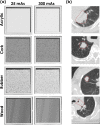Effect of tube current on computed tomography radiomic features
- PMID: 29403060
- PMCID: PMC5799381
- DOI: 10.1038/s41598-018-20713-6
Effect of tube current on computed tomography radiomic features
Abstract
Variability in the x-ray tube current used in computed tomography may affect quantitative features extracted from the images. To investigate these effects, we scanned the Credence Cartridge Radiomics phantom 12 times, varying the tube current from 25 to 300 mA∙s while keeping the other acquisition parameters constant. For each of the scans, we extracted 48 radiomic features from the categories of intensity histogram (n = 10), gray-level run length matrix (n = 11), gray-level co-occurrence matrix (n = 22), and neighborhood gray tone difference matrix (n = 5). To gauge the size of the tube current effects, we scaled the features by the coefficient of variation of the corresponding features extracted from images of non-small cell lung cancer tumors. Variations in the tube current had more effect on features extracted from homogeneous materials (acrylic, sycamore wood) than from materials with more tissue-like textures (cork, rubber particles). Thirty-eight of the 48 features extracted from acrylic were affected by current reductions compared with only 2 of the 48 features extracted from rubber particles. These results indicate that variable x-ray tube current is unlikely to have a large effect on radiomic features extracted from computed tomography images of textured objects such as tumors.
Conflict of interest statement
The authors declare that they have no competing interests.
Figures






References
-
- Fried DV, et al. Potential Use of (18)F-fluorodeoxyglucose Positron Emission Tomography-Based Quantitative Imaging Features for Guiding Dose Escalation in Stage III Non-Small Cell Lung Cancer. International journal of radiation oncology, biology, physics. 2016;94:368–376. doi: 10.1016/j.ijrobp.2015.10.029. - DOI - PubMed
-
- van Rossum PS, et al. The incremental value of subjective and quantitative assessment of 18F-FDG PET for the prediction of pathologic complete response to preoperative chemoradiotherapy in esophageal cancer. Journal of Nuclear Medicine. 2016;57:691–700. doi: 10.2967/jnumed.115.163766. - DOI - PubMed
-
- Scrivener M, et al. Radiomics applied to lung cancer: a review. Translational Cancer Research. 2016;5:398–409. doi: 10.21037/tcr.2016.06.18. - DOI
Publication types
MeSH terms
Grants and funding
LinkOut - more resources
Full Text Sources
Other Literature Sources
Medical

